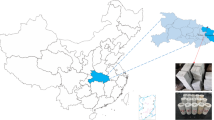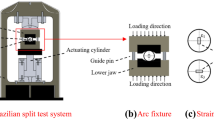Abstract
Brazilian tests and 3D fracture surface measurements were carried out on granite subjected to different temperatures (25, 100, 200, 300, and 400 °C) followed by different cooling treatments (water cooling and liquid nitrogen cooling treatments). The tensile strength, peak displacement, failure mode, and fracture surface roughness of granite were compared and analyzed. The energy absorption and fracture modes during failure processes were analyzed based on cumulative acoustic emission energy, rise angle (RA), average frequency (AF), and cluster analysis. The results show that the variations in tensile properties can be divided into two temperature zones (25–100 °C and 100–400 °C) for granite after water cooling and three temperature zones (25–100 °C, 100–200 °C, and 200–400 °C) for granite after liquid nitrogen cooling. There was a turning point temperature in the temperature range of 100–200 °C due to the relative heat transfer capacity between liquid nitrogen and water. Below the turning point temperature, the tensile property deterioration after liquid nitrogen cooling was greater than that after water cooling. Above the turning point temperature, the tensile property deterioration after liquid nitrogen cooling was less than that after water cooling due to the Leidenfrost effect. When the temperature was > 200 °C, the liquid nitrogen cooling treatment resulted in more shear crack or mixed crack propagation during the failure process of granite, which promoted an increase in the fracture surface roughness.














Similar content being viewed by others
References
Aggelis, D. G. (2011). Classification of cracking mode in concrete by acoustic emission parameters. Mechanics Research Communications, 38(3), 153–157.
Asai, P., Panja, P., McLennan, J., & Moore, J. (2019). Efficient workflow for simulation of multifractured enhanced geothermal systems (EGS). Renewable Energy, 131, 763–777.
Barbier, E. (2002). Geothermal energy technology and current status: An overview. Renewable and Sustainable Energy Reviews, 6(1), 3–65.
Boussaid, M. S., Mallet, C., Beck, K., & Clara, J. (2020). Multi-geophysical approach for the characterization of thermally-induced cracks in granite: Discussion of reproducibility and persistence. Pure and Applied Geophysics, 177(7), 3301–3314.
Breede, K., Dzebisashvili, K., Liu, X., & Falcone, G. (2013). A systematic review of enhanced (or engineered) geothermal systems: Past, present and future. Geothermal Energy, 1(1), 4.
Cai, C., Gao, F., & Yang, Y. (2018). The effect of liquid nitrogen cooling on coal cracking and mechanical properties. Energy Exploration & Exploitation, 36(6), 1609–1628.
Cai, C., Li, G., Huang, Z., Tian, S., Shen, Z., & Fu, X. (2015). Experiment of coal damage due to super-cooling with liquid nitrogen. Journal of Natural Gas Science and Engineering, 22, 42–48.
Cha, M., Yin, X., Kneafsey, T., Johanson, B., Alqahtani, N., Miskimins, J., et al. (2014). Cryogenic fracturing for reservoir stimulation–Laboratory studies. Journal of Petroleum Science and Engineering, 124, 436–450.
Chen, S., Yang, C., Wang, G., & Liu, W. (2017). Similarity assessment of acoustic emission signals and its application in source localization. Ultrasonics, 75, 36–45.
Curtis, G. J. (1975). Acoustic emission energy relates to bond strength. Non-Destructive Testing, 8(5), 249–257.
Du, K., Li, X., Tao, M., & Wang, S. (2020). Experimental study on acoustic emission (AE) characteristics and crack classification during rock fracture in several basic lab tests. International Journal of Rock Mechanics and Mining Sciences, 133, 104411.
Du, M., Gao, F., Cai, C., Su, S., & Wang, Z. (2021). Experimental Study on the Damage and Cracking Characteristics of Bedded Coal Subjected to Liquid Nitrogen Cooling. Rock Mechanics and Rock Engineering, 54(11), 5731–5744.
Eberhardt, E., Stead, D., Stimpson, B., & Read, R. S. (1998). Identifying crack initiation and propagation thresholds in brittle rock. Canadian Geotechnical Journal, 35(2), 222–233.
Fan, L., Gao, J., Du, X., & Wu, Z. (2020). Spatial gradient distributions of thermal shock-induced damage to granite. Journal of Rock Mechanics and Geotechnical Engineering, 12(5), 917–926.
Hou, P., Liang, X., Gao, F., Dong, J., He, J., & Xue, Y. (2021a). Quantitative visualization and characteristics of gas flow in 3D pore-fracture system of tight rock based on Lattice Boltzmann simulation. Journal of Natural Gas Science and Engineering, 89, 103867.
Hou, P., Liang, X., Zhang, Y., He, J., Gao, F., & Liu, J. (2021b). 3D multi-scale reconstruction of fractured shale and influence of fracture morphology on shale gas flow. Natural Resources Research, 30(3), 2463–2481.
Hou, P., Su, S., Liang, X., Gao, F., Cai, C., Yang, Y., et al. (2021). Effect of liquid nitrogen freeze–thaw cycle on fracture toughness and energy release rate of saturated sandstone. Engineering Fracture Mechanics, 258, 108066.
Hou, P., Xue, Y., Gao, F., Dou, F., Su, S., Cai, C., et al. (2022). Effect of liquid nitrogen cooling on mechanical characteristics and fracture morphology of layer coal under Brazilian splitting test. International Journal of Rock Mechanics and Mining Sciences, 151, 105026.
Hu, J., Xie, H., Sun, Q., Li, C., & Liu, G. (2021). Changes in the thermodynamic properties of alkaline granite after cyclic quenching following high temperature action. International Journal of Mining Science and Technology, 31(5), 843–852.
Isaka, B. L. A., Gamage, R. P., Rathnaweera, T. D., Perera, M. S. A., Chandrasekharam, D., & Kumari, W. G. P. (2018). An influence of thermally-induced micro-cracking under cooling treatments: Mechanical characteristics of Australian granite. Energies, 11(6), 1338.
Isaka, B. L. A., Ranjith, P. G., Rathnaweera, T. D., Perera, M. S. A., & De Silva, V. R. S. (2019). Quantification of thermally-induced microcracks in granite using X-ray CT imaging and analysis. Geothermics, 81, 152–167.
ISRM. (1978). Suggested methods for determining tensile strength of rock materials. International Journal of Rock Mechanics and Mining Sciences & Geomechanics Abstracts, 15(3), 99–103.
Kang, F., Jia, T., Li, Y., Deng, J., Tang, C., & Huang, X. (2021). Experimental study on the physical and mechanical variations of hot granite under different cooling treatments. Renewable Energy, 179, 1316–1328.
Kordatos, E. Z., Aggelis, D. G., & Matikas, T. E. (2012). Monitoring mechanical damage in structural materials using complimentary NDE techniques based on thermography and acoustic emission. Composites Part B Engineering, 43(6), 2676–2686.
Kumari, W. G. P., Beaumont, D. M., Ranjith, P. G., Perera, M. S. A., Avanthi Isaka, B. L., & Khandelwal, M. (2019). An experimental study on tensile characteristics of granite rocks exposed to different high-temperature treatments. Geomechanics and Geophysics for Geo-Energy and Geo-Resources, 5(1), 47–64.
Kumari, W. G. P., Ranjith, P. G., Perera, M. S. A., & Chen, B. K. (2018). Experimental investigation of quenching effect on mechanical, microstructural and flow characteristics of reservoir rocks: Thermal stimulation method for geothermal energy extraction. Journal of Petroleum Science and Engineering, 162, 419–433.
Kumari, W. G. P., Ranjith, P. G., Perera, M. S. A., Chen, B. K., & Abdulagatov, I. M. (2017). Temperature-dependent mechanical behaviour of Australian Strathbogie granite with different cooling treatments. Engineering Geology, 229, 31–44.
Liang, X., Hou, P., Xue, Y., Yang, X., Gao, F., & Liu, J. (2021). A fractal perspective on fracture initiation and propagation of reservoir rocks under water and nitrogen fracturing. Fractals, 29(07), 2150189.
Liu, X., Liu, Z., Li, X., Gong, F., & Du, K. (2020). Experimental study on the effect of strain rate on rock acoustic emission characteristics. International Journal of Rock Mechanics and Mining Sciences, 133, 104420.
Liu, X., Liu, Z., Lu, X., Han, M., & Yang, L. (2019). Acoustic emission and micro-rupture characteristics of rocks under Brazilian splitting load. Chinese Journal of Engineering, 41(11), 1422–1432.
Ma, W., Wang, Y., Wu, X., & Liu, G. (2020). Hot dry rock (HDR) hydraulic fracturing propagation and impact factors assessment via sensitivity indicator. Renewable Energy, 146, 2716–2723.
McCartney, J. S., Sánchez, M., & Tomac, I. (2016). Energy geotechnics: Advances in subsurface energy recovery, storage, exchange, and waste management. Computers and Geotechnics, 75, 244–256.
Memon, K. R., Mahesar, A. A., Ali, M., Tunio, A. H., Mohanty, U. S., Akhondzadeh, H., et al. (2020). Influence of cryogenic liquid nitrogen on petro-physical characteristics of Mancos shale: An experimental investigation. Energy & Fuels, 34(2), 2160–2168.
Ohno, K., & Ohtsu, M. (2010). Crack classification in concrete based on acoustic emission. Construction and Building Materials, 24(12), 2339–2346.
Ohtsu, M., & Tomoda, Y. (2007). Corrosion process in reinforced concrete identified by acoustic emission. Materials Transactions, 48, 1184–1189.
Pan, S., Gao, M., Shah, K. J., Zheng, J., Pei, S., & Chiang, P. (2019). Establishment of enhanced geothermal energy utilization plans: Barriers and strategies. Renewable Energy, 132, 19–32.
Qin, L., Zhai, C., Xu, J., Liu, S., Zhong, C., & Yu, G. (2019). Evolution of the pore structure in coal subjected to freeze-thaw using liquid nitrogen to enhance coalbed methane extraction. Journal of Petroleum Science and Engineering, 175, 129–139.
Rodriguez, P., & Celestino, T. B. (2019). Application of acoustic emission monitoring and signal analysis to the qualitative and quantitative characterization of the fracturing process in rocks. Engineering Fracture Mechanics, 210(SI), 54–69.
Sha, S., Rong, G., Chen, Z., Li, B., & Zhang, Z. (2020). Experimental evaluation of physical and mechanical properties of geothermal reservoir rock after different cooling treatments. Rock Mechanics and Rock Engineering, 53, 4967–4991.
Tang, S., Wang, J., & Chen, P. (2020). Theoretical and numerical studies of cryogenic fracturing induced by thermal shock for reservoir stimulation. International Journal of Rock Mechanics and Mining Sciences, 125, 104160.
Tomac, I., & Sauter, M. (2018). A review on challenges in the assessment of geomechanical rock performance for deep geothermal reservoir development. Renewable and Sustainable Energy Reviews, 82, 3972–3980.
Wang, D., Bian, X., Qin, H., Sun, D., & Yu, B. (2021a). Experimental investigation of mechanical properties and failure behavior of fluid-saturated hot dry rocks. Natural Resources Research, 30(1), 289–305.
Wang, D., Zhou, F., Dong, Y., Sun, D., & Yu, B. (2021b). Experimental investigation of thermal effect on fracability index of geothermal reservoirs. Natural Resources Research, 30(1), 273–288.
Wu, X., Huang, Z., Li, R., Zhang, S., Wen, H., Huang, P., et al. (2018). Investigation on the damage of high-temperature shale subjected to liquid nitrogen cooling. Journal of Natural Gas Science and Engineering, 57, 284–294.
Wu, X., Huang, Z., Zhang, S., Cheng, Z., Li, R., Song, H., et al. (2019a). Damage analysis of high-temperature rocks subjected to LN2 thermal shock. Rock Mechanics and Rock Engineering, 52(8), 2585–2603.
Wu, Q., Weng, L., Zhao, Y., Guo, B., & Luo, T. (2019b). On the tensile mechanical characteristics of fine-grained granite after heating/cooling treatments with different cooling rates. Engineering Geology, 253, 94–110.
Xie, H., Li, C., Zhou, T., Chen, J., Liao, J., Ma, J., et al. (2020). Conceptualization and evaluation of the exploration and utilization of low/medium-temperature geothermal energy: A case study of the Guangdong-Hong Kong-Macao Greater Bay Area. Geomechanics and Geophysics for Geo-Energy and Geo-Resources, 6(1), 18.
Xie, H., Peng, R., Ju, Y., & Zhou, H. (2005). On energy analysis of rock failure. Chinese Journal of Rock Mechanics and Engineering, 24(15), 2603–2608.
Yang, R., Hong, C., Liu, W., Wu, X., Wang, T., & Huang, Z. (2021). Non-contaminating cryogenic fluid access to high-temperature resources: Liquid nitrogen fracturing in a lab-scale Enhanced Geothermal System. Renewable Energy, 165, 125–138.
Yang, R., Huang, Z., Shi, Y., Yang, Z., & Huang, P. (2019). Laboratory investigation on cryogenic fracturing of hot dry rock under triaxial-confining stresses. Geothermics, 79, 46–60.
Zhang, H., Huang, Z., Zhang, S., Yang, Z., & Mclennan, J. D. (2020). Improving heat extraction performance of an enhanced geothermal system utilizing cryogenic fracturing. Geothermics, 85, 101816.
Acknowledgments
This study was funded by the National Natural Science Foundation of China (No. 51827901) and the National Key Research and Development Program of China (No. 2020YFA0711800).
Author information
Authors and Affiliations
Corresponding author
Ethics declarations
Conflict of Interest
The authors declared that there is no conflict of interest.
Rights and permissions
About this article
Cite this article
Zhou, C., Gao, F., Cai, C. et al. Effect of Different Cooling Treatments on the Tensile Properties and Fracture Modes of Granite Heated at Different Temperatures. Nat Resour Res 31, 817–833 (2022). https://doi.org/10.1007/s11053-022-10027-w
Received:
Accepted:
Published:
Issue Date:
DOI: https://doi.org/10.1007/s11053-022-10027-w




